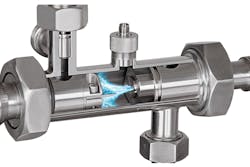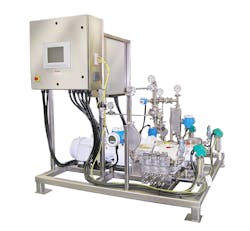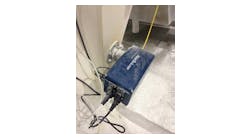Generally, two types of homogenizers are available for processing disparate fluids and creating a uniform emulsion. The first type is the rotor/stator high-shear style that uses mechanical rotational shear to essentially beat an emulsion into existence. Mechanical shear tears the discontinuous or oily phase of a would-be emulsion into smaller droplets allowing for a suspension. The other type is the high-pressure homogenizer that uses a restriction in the line that subjects fluid to instant acceleration and cavitation. The acceleration comes from forcing the fluid via a positive-displacement (PD) pump through an orifice nozzle or a partially closed valve. The cavitation comes from the voids formed as the fluid changes speed over a very short distance.
In many instances, the rotor/stator types of homogenizers come as single-feed units that are used inside a tank or inline underneath the tank, usually in a recirculation loop. To use these, the processor is married to a labor-intensive batch method in which various ingredients are fed to the tank manually one at a time. In the best cases, manufacturers have devised methods to automatically transfer these materials to reduce labor, but still meter the ingredients singularly based on weight gain in a tank on load cells. More sophisticated manufacturers, for a large cost, have taken it a step further and employed mass or volumetric flowmeters to dump materials simultaneously.
Although efficiencies have been created by doing this to reduce labor involvement, all materials must ultimately be transferred to a single large-batch tank, and the inbound transfer times, mixing times and transfer times all add up. Operator involvement is still heavy as these transitions from material feeding to mixing to transferring out need to be overseen and managed. Things get worse when higher temperatures are required to heat various materials that require heating to become liquid or to do their job. It’s even worse, still, if order of addition rules need to be followed — A must precede B for C to be dumped next, and so on.
All of this leads to a large tank with a whole lot of fluid, much of which could be water, and much, or all, of which could now be at elevated temperature. Water in a tank is wasteful in so many ways. Tank space is precious, so it behooves any manufacturer to reduce how much of it must be transferred to a tank. Take a typical lotion emulsion for instance. Most manufacturers start with two tanks, an oil phase and an aqueous phase, both hot. The aqueous phase might be as much as 60 to 70 percent plain, old water. The two premixes are then merged to a single tank, homogenized and cooled. In some cases, this can be a 12-hour process, most of which is actually heating and cooling time as well as the transfer time to merge the two premixes to a single tank and transfer out a cooled, more viscous lotion.
There’s a more efficient and time-saving method that can be used, and it’s a mouthful. Ready? Inline multiple-feed, high-pressure homogenization. This method uses an inline homogenizing device that is coupled to several PD pumps in an integrated and preprogrammed system that meters bulk materials, water and smaller, more manageable premixes inline to instantly form an emulsion that, in many cases, doesn’t require any cooling. In the previously mentioned example with lotions, the process can be made more efficient by using a dual-feed homogenizing system that meters the two premixes at ratio and subjects the combined stream to anywhere from 500 to 2,000 psi and creates a beautiful emulsion inline.
Take it a step further and now you can reduce the temperature of the aqueous phase; the only reason this phase is elevated in temperature is to allow for a gentle merging of the two tanks. Now that they are merging inline at high pressure, the incoming temperatures of the phases can be different and the result is a cooler emulsion that now looks very close to the fillable end product. Cooling time is reduced significantly, or even eliminated altogether. And transfer time is absorbed into the emulsion-making time so it’s a huge time-savings win. Taking it even further, anywhere from 25 to 50 percent of the water can now be removed from that aqueous phase and metered directly from a deionized (DI) water supply using a third PD pump and flowmeter that would be integrated into the system.
This example, give or take, can be seen in all industries. A simple example in the chemical industry would be metering silicone fluid, water and a surfactant at proper ratio through an inline homogenizing device at high pressure to create a uniform emulsion. No batch tank and no premixing of any kind is required. In textiles, neat oils that apply to yarn better when emulsified with water typically use only three ingredients that can be metered from bulk and emulsified inline, again without batching tanks.
A multiple-feed, inline homogenizer system concept where a hot oil phase and cool aqueous phase are metered at high pressure to make an instant emulsion inline
Another benefit of the inline multiple-feed homogenizing method is increased product yield for given tank space. This means that in cases where a premix is necessary — to allow for minor solid ingredients, etc. — the goal is to yield as much finished product from that one tank as possible and minimize the amount of water used in the premix. In personal care, an aqueous premix is required and is metered alongside DI water, SLES (a common surfactant used in personal care items) and and other soap-based raw ingredients not placed in a tank to make shampoo and body wash inline. If the premix winds up being 20–25 percent or so of the total volume, about three to four times as much product can now be made with a single tank compared to any batch method — this is because the remaining balance of water, SLES and other bulk materials is homogenized inline directly from their respective sources.
A production-scale, multiple-feed Sonolator homogenizing system used to process personal care fluids that use SLES, water and other ingredients. This system makes 20 tons of product using a 5-ton aqueous premix tank.
Conclusion
Moving away from tank and batch processing and into this world of multiple-feed processing will almost always save time and money. It will reduce labor involvement and reduce errors and waste. One of the hurdles to considering this approach is the idea that making emulsions is actually tricky. It’s not like dealing with miscible fluids that play nice with each other. Oils and water need to be forced together; they don’t like hanging around in a tank together for very long. So keep water out of those tanks and look into multiple-feed, high-pressure homogenization.
A multiple-feed Sonolator homogenizing system featuring two or more PD pumps with mass flowmeters and inline homogenizer device.
Rob Brakeman is the owner/director of Sonic Corp. Brakeman attended the Northfield Mount Hermon School and Gettysburg College. His company specializes in the custom design and fabrication of high-pressure homogenizer systems and inline blending skids. The company’s flagship homogenizer, the Sonolator, is designed into custom systems that emulsify and disperse a wide range of fluids in all major industries. Brakeman and his team have more than 125 years of combined experience in and out of large capacity manufacturing facilities around the world. It is this experience that has provided him with 25 years of knowledge and understanding of a wide variety of process environments and issues. Brakeman may be reached at 203-375-0063 or [email protected].





